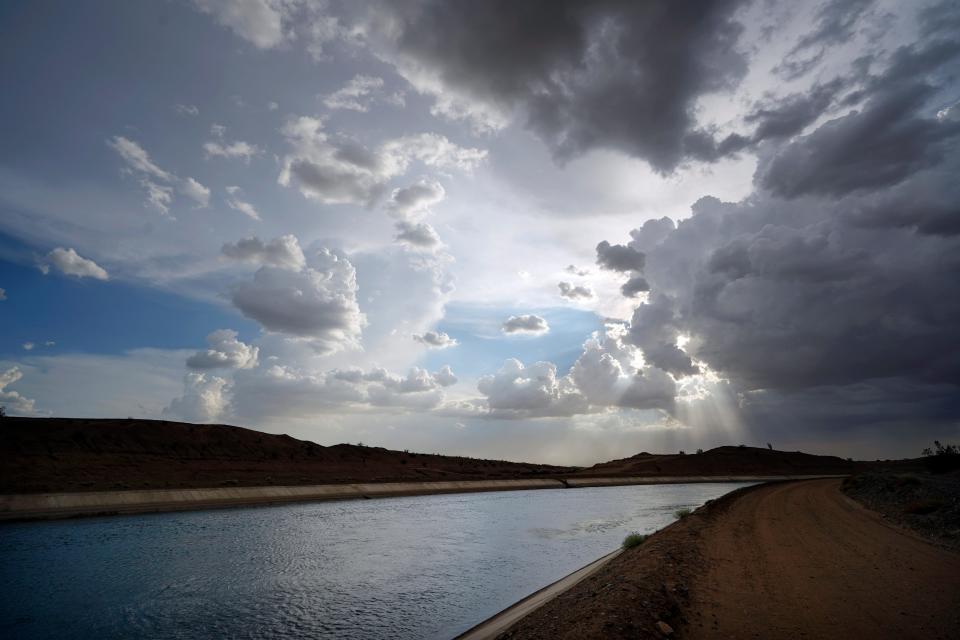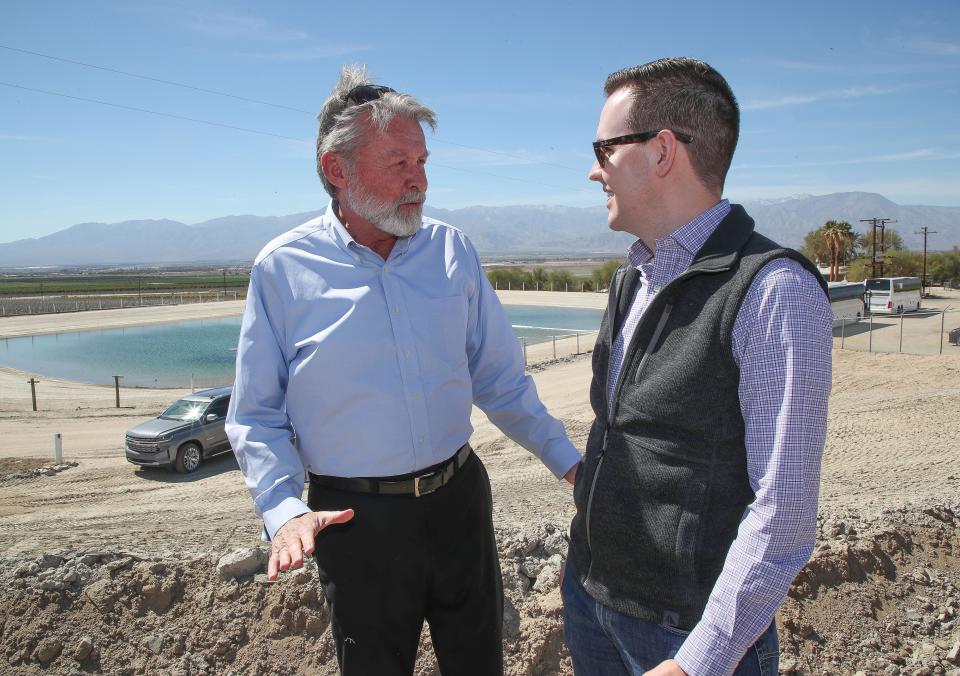California likely spared Colorado River cuts in 2024, but long-term woes remain
California will likely not face any cuts in Colorado River supply in 2024, according to a new forecast released on Tuesday by the U.S. Bureau of Reclamation. The agency said heavy snowpack and rains last winter mean planned reductions can be eased slightly from more urgent levels last year.
But Arizona will still lose as much as 18% of its river allocation, and Nevada and Mexico could lose smaller amounts, under pre-determined levels set by federal, international and state officials to account for shortages. And no one's breathing easy, with the long-term prognosis for the river still grim due to overuse coupled with ever longer droughts exacerbated by climate change.
Federal officials and the seven states that rely on the river have already begun negotiating the future of the river system after 2026, when current operating guidelines expire. U.S. Bureau of Reclamation and Department of Interior officials are also studying voluntary proposals by the states to keep the river's two massive reservoirs, Lake Mead and Lake Powell, functional through 2026.

Earlier this year, California, Arizona and Nevada submitted a plan to conserve an additional 3 million acre-feet of water through 2026 in exchange for $1.2 billion from the federal government. An acre-foot of water is enough to serve two to four households annually. To reach that goal, the Imperial Irrigation District, which holds the largest and among the oldest rights to Colorado River water, has submitted a proposal to conserve up to one million acre feet in the next three years, largely via seasonal fallowing of farmland, in exchange for nearly $700 million in federal funds. The Interior Department is expected to release its analysis of the three-state plan this fall and finalize it in 2024.
An estimated 40 million people and more than 5 million acres of farmland, including more than half a million acres in Southern California, depend on the Colorado River system. While the wet winter and spring combined with conservation efforts helped somewhat, both reservoirs are still below 40% of capacity.
Lake Mead's Jan. 1 water level is projected to reach more than 1,065 feet above sea level, so on Tuesday, the Bureau of Reclamation said it would operate the river and its reservoirs under Level 1 shortage conditions in 2024, a step down from the stricter Level 2 conditions imposed in 2023. Even so, next year's releases from Lake Mead to downstream users would be the lowest in 30 years, and about 1.5 million acre-feet lower than in an average year.
“The above-average precipitation this year was a welcome relief, and coupled with our hard work for system conservation, we have the time to focus on the long-term sustainability solutions needed in the Colorado River Basin. However, Lake Powell and Lake Mead — the two largest reservoirs in the United States and the two largest storage units in the Colorado River system — remain at historically low levels,” said Reclamation Commissioner Camille Calimlim Touton in a statement.
“As we experience a warmer, drier west due to a prolonged drought, accelerated by climate change, Reclamation is committed to leading inclusive and transparent efforts to develop the next-generation framework for managing the river system," the statement continued.
Tread lightly with historic agreements, three states warn
Top officials from California, Arizona and Nevada, recognizing likely long-term shortages, wrote a somewhat strongly worded letter to Touton on Tuesday acknowledging the need for deeper cuts, but saying existing century-old agreements, including delivery obligations to Mexico, must not be tossed aside completely, unless they want to risk extended lawsuits.
"The Lower Division States believe the Law of the River must be the foundation for the Post-2026 Operations. The existing framework also allows for collaboration and consensus which helps avoid the uncertain outcomes that result from litigation," they wrote.
An experimental program in the four Upper Basin states that also rely on river water should not be used to determine future allocations, they wrote, and possible use of desalinated water or other outside supply to replenish the river should also be considered. Arizona's top water official has said in the past that desalinated water piped from Mexico to boost their supply is "an absolute necessity." But others say that idea and others for replenishing the supply are not realistic.
Jenny Ross, an Imperial County based researcher, also wrote federal officials on Tuesday to say the Salton Sea, which is dwindling rapidly due to previous cuts of river water to the area, must be shored up in the future.
"Additional reductions in allocations of Colorado River water will intensify and accelerate the Salton Sea’s existential crisis and the associated damage to public health and wildlife that is already unfolding ... and will ultimately destroy the lake’s ecosystem, devastate migratory bird populations, push an endangered fish toward extinction, and cause potentially irreparable harm to more than half a million people," she wrote. "Federal support for mitigation activities at the Salton Sea on an ad hoc and piecemeal basis has been, and will continue to be, an inadequate approach for addressing the lake’s crisis. Instead, effective and permanent Salton Sea restoration is required."

Two environmental groups that track Colorado River water issues, Great Basin Water Network and Living Rivers, released a joint statement entitled "The Brink Will Be Back," warning that without further reductions in water use, the region's warming will bring the system back to the brink soon enough.
“Climate change gives us very little breathing room to refill reservoirs,” said Kyle Roerink, who directs Great Basin Water Network. "More pain is coming for plant life, wildlife and human life, and I have little faith that water managers will take the proper long-term course to mitigate the hardship.”
The two groups and IID's new water consultant, Jeffrey Kightlinger, also warn that public dollars alone won't solve the problem.
Farmers and major cities not immediately impacted
Farmers use between 70% and 80% of all water in the Colorado River system, but Tuesday’s announcement will not change much for most of them, including in the Coachella and Imperial valleys, with existing voluntary conservation programs to remain in place.
One farming district in Arizona’s Pinal County outside of Phoenix lost almost its entire Colorado River water supply in 2022, though, and the district won’t get it back. Instead, farmers have turned to groundwater or left fields unplanted. As much as half the farmland has been fallowed in the past two years, said Brian Yerges, general manager of the Maricopa-Stanfield Irrigation and Drainage District, which serves them.
Along with Palm Springs and the Coachella Valley, major cities are unlikely to be impacted by Tuesday’s announcement. Phoenix, for example, has a mix of water from the Colorado and the in-state Salt and Verde rivers, along with groundwater and recycled wastewater that it uses to serve residents in the fifth-largest U.S. city.
In the Las Vegas area, ornamental lawns are banned, swimming pool sizes are limited and almost all water used inside homes is recycled back into larger supplies once it drains from taps or showers, limiting the impact of water cuts. The Southern Nevada Water Authority said strict conservation measures will continue.
The Metropolitan Water District of Southern California, which supplies nearly 20 million people, lifted water restrictions in March for nearly 7 million of those residents. In addition to the Colorado River, the district draws from rivers in Northern California that swelled with spring runoff. The Coachella Valley also receives some water allocations from upstate.

First woman appointed to run IID
Separately on Tuesday, IID's board of directors voted unanimously to appoint Jamie Asbury, the agency's current energy department manager, as general manager of what they said is the nation’s largest irrigation district and third-largest public power provider in California. She is the first woman to lead the agency in its 112-year history.
Asbury, an attorney by trade, will run the agency at a critical juncture, with a long-term agreement to provide much of the Coachella Valley with electricity also expiring in coming years.
“IID is an established and driving force in both the energy and water sectors on regional and national levels and it has a tremendous responsibility to serve the public good,” Asbury said. “I am excited and humbled by the opportunity to lead this organization at such an important time in its history."
Janet Wilson is senior environment reporter for The Desert Sun, and a Stanford Lane Center western media fellow.
Barandon Loomis with the Arizona Republic and the Associated Press contributed to this report.
This article originally appeared on Palm Springs Desert Sun: California likely spared Colorado River cuts in 2024. Future woes remain

